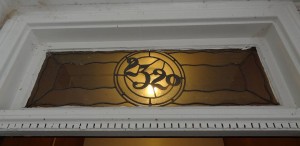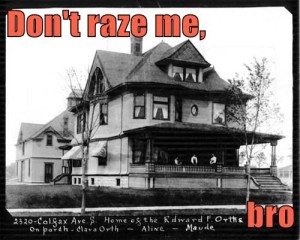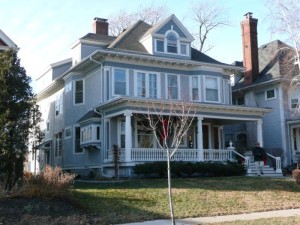
Welcome to the
Healy Project
Join us on Facebook
Send us an Email
Stop Demolition: Allow a designation study for the Orth House
Demand that Minneapolis, the “Zero Waste” City, allow the ordered designation study for the historic Orth House to be done.

Last week the Minneapolis Zoning and Planning Committee, after listening to an hour of testimony, voted on a motion from CM Bender (Ward 10) to approve the owner’s appeal to demolish the Orth House, 2320 Colfax Ave. S. Lisa Goodman (Ward 7) was the lone dissenter. This vote overturned the decision of the Heritage Preservation Commission to allow the house interim protection (180 days) while a designation study is done. CM Bender must be called to account.
Last year the HPC declared the house to be an “historic resource” and the City Council unanimously upheld this decision. The owner, Michael Crow, and developer, Michael Lander, came back to the HPC this year, saying a designation study hadn’t been done and asking again for a permit to demolish an historic resource. The HPC reaffirmed their previous decision, and ordered a study.
Why wasn’t a designation study done? So far, we have no answer. The issue before the City Council is whether or not viable alternatives to demolition exist for the house. Ignoring the testimony of experts like architect John Cuningham (whose firm did the Uptown small area plan) and structural specialist John Jepsen, who both examined the house inside and out, CM Bender based her opinion on the testimony of those who would reap substantial financial gain from the house’s demolition: the owner, his broker, and the developer.
CM Bender declared that it is not feasible to rehab the house as a single-family home. No one testifying suggested that option, focusing instead on the need for affordable multi-family housing in the city. The owner, Michael Crow, declared that he has spent $250k on improvements to the house. City inspections records show that he spent less than $24k. Last year Crow’s broker, Tom Dunne, when asked directly if he marketed the property on residential MLS, said yes, but admitted this year that he has not. Is the Minneapolis City Council simply going to accept the claims of the owner and broker as fact? Shouldn’t all allegations by appellants be fact-checked by the City?

The City Council should not be taking the word of the owner or developer, or anyone else, on faith. Unless the designation study is done, we have no way of knowing who is giving an accurate, fact-based assessment of the house. Since the vote last year, nothing has changed with the condition of the house or the City ordinances governing historic resources. Ask the CMs on Z&P who voted to grant the house protection last year to justify their change of position (Kevin Reich 1, Barbara Johnson 4). Ask the other CMs who voted last year to follow correct procedure and allow the designation study to go forward (Cam Gordon 2, Elizabeth Glidden 8, John Quincy 11). Copy Mayor Betsy Hodges, who served as CM Ward 13 last year. Ask the new CMs to let the study proceed. Send an e-mail to CM Goodman, thanking her for her support.
Let the City Council’s decision about the Orth House be based on verifiable facts, not the appellants’ unsupported allegations.
The full vote of the City Council on this motion will be held, without public hearing, on Friday, April 25th, at 9:30.
Contact city council members NOW and ask that the City follow correct procedure and allow the designation study to be done. Keep your message short and to the point. Request a response. For a list of current Council members, see http://www.ci.minneapolis.mn.us/council/
 _________________________________________________________
_________________________________________________________
What the facts are:
Re: Sustainability. While the City is touting its “Zero-Waste” initiative, City Council is heading towards approving the demolition of a sound, historic house, sending 180+ tons of materials to the landfill. The City and the developer are using “trickle-down” sustainability, putting the responsibility on the project’s residents, who are expected to sell their cars, bike, use public transportation, and recycle.

Minneapolis, the Zero Waste city, wants us to recycle and ride bikes–while the City sends hundreds of tons of historic houses to the landfill.
Re: Density. The developer claims that his so-called “Eco-flats” will provide needed density on transit hubs, a goal of the City Planning Dept. Density and transit hubs already exist in the Wedge. These amenities are there now, new development or not. The population of the Wedge is being increased by 47% by new development along the Greenway. How much density can the neighborhood absorb?
Re: Neighborhood support. The Lowry Hill East Neighborhood Association does not support the Lander development. A motion to approve the project did not pass the board. A survey of e-mails to the City regarding this issue shows overwhelming support for the house by residents with addresses in the Wedge.
Re: Affordability. Rent in new buildings, to be economically feasible for the developer, must be set at market rate or higher. The 1,800 new units in the Wedge are luxury housing. The Lander project will bring more gentrification, marketing to affluent white people. The affordable housing is the existing houses and apartments, not new construction. A perfect site for an apartment project is available at Franklin and Park. Why doesn’t the City urge Lander to build there, rather than facilitating the wrecking of an historic resource?
Re: Preservation. As noted in the 1981 article in Twin Cities magazine, 2320 Colfax is the transitional design in the career of celebrated master builder Theron Potter Healy. The Heritage Preservation Commission determined that the house is an historic resource. But the City thinks historic houses are worth saving only if they are in “good” neighborhoods. As CM Goodman observed, “This house will see an untimely death as a result of its location. If this was in Lowry Hill or Kenwood we would not be having this conversation.”
STOP DEMOLITION
Ask CMs to pay attention to the presentation of these facts at Z&P last week. Demand that the City follow protocol and allow the study ordered by the HPC to be completed.
Council Members by Ward:
1. kevin.reich@minneapolismn.gov, 2. cam.gordon@minneapolismn.gov, 3.jacob.frey@minneapolismn.gov, 4. barbara.johnson@minneapolismn.gov, 5.blong.yang@minneapolismn.gov, 6.abdi.warsame@minneapolismn.gov, 8.elizabeth.glidden@minneapolismn.gov, 9.alondra.cano@minneapolismn.gov, 10.lisa.bender@minneapolismn.gov,11. john.quincy@minneapolismn.gov, 12.andrew.johnson@minneapolismn.gov, 13. linea.palisano@minneapolismn.gov
Thank Lisa Goodman for her support 7.lisa.goodman@minneapolismn.gov
This Healy house, a design descendant of the Orth House, is on Lowry Hill.
In promoting their new projects, developers repeatedly trot out claims based on the tenets of New Urbanism: affordability, diversity, easy access, and sustainability.
“New Urbanism promotes the creation and restoration of diverse, walkable, compact, vibrant, mixed-use communities composed of the same components as conventional development, but assembled in a more integrated fashion, in the form of complete communities. These contain housing, work places, shops, entertainment, schools, parks, and civic facilities essential to the daily lives of the residents, all within easy walking distance of each other.”–NewUrbanism.org

Want to live in hip, starry-neon-skied Lime in the Wedge Greenway, where (as their sign proclaims) “tarts” are welcome? Prepare to shell out big bucks for a small space.
Let’s look at the claims of the Lander Group for its proposal at 2316-2320 Colfax Avenue South and see how they square with the aims noted above. Lander wants to wreck the Orth House at 2320 to clear the site for a 45-unit apartment building. The Lander website says that the 2320 project is “geared to more affordable budgets with the smaller sizing, and real transportation options.” To be cost-effective for the developer, the rents in new units need to be set at least at market rate. Currently, rents for 500-square-foot studios in new Wedge buildings start at $1200 per month. This is not “affordable” housing by any stretch of the imagination. Even if Lander/At Home do as stated keep the rent under $1,000 to start with (still above average for the area), there’s nothing to stop them from raising it afterward. This is exactly what happened at the joint Lander-Gerberding apartment project at 46th and 46th. They were initially advertised as market rate [1], but now are luxury [2]. If the developer is serious about affordability, let him sign a contract with the City for a fixed-rent range.
The fact is that the older rental units are the affordable ones. New apartment construction, to be cost effective for the developer, must have rents set higher than for existing structures. The result is what we now have in the Wedge Greenway: 1800+ units built or under construction that are inhabited largely by young, affluent white people. The aim of the marketing campaigns for these Greenway apartments is to attract young suburbanites to the city for a few years before they settle down in neighborhoods of mostly single-family homes: “Don’t get hitched until you enjoy your year at Lime”, “I don’t remember her name, but her apartment” (Elan). This kind of marketing and pricing does not produce a racially, socially or economically diverse community, but an enclave of privileged “urban tourists,” slumming in the Wedge for a few years. So much for developers adhering to the “diversity” and “affordable” parts of New Urbanist planning.
The Lander website touts “real transportation options” (as opposed to imagined options?) available to future tenants. “The building concept promotes ‘green’ living – close to and providing a variety of transportation options, services, recreation, and green space.” Lander’s “concept” has not produced these amenities, which are available to anyone living in the area. Bus lines run on Hennepin, Lyndale, and Franklin right now.The Wedge has always been a very walkable part of the city, close to lakes, parks, and shopping. Minneapolis is currently the most bike-friendly city in the country. Hour Cars are available now at Franklin and Dupont, a short walk away; bike racks can be built into any structure.

In addition, the developer and development supporters totally ignore New Urbanism’s mandate to conserve resources: to lift people out of poverty, to use energy wisely, and to build community. An important part of this mandate is to preserve the cultural resources and history of the community–an aspect developers conveniently forget, and in fact, as is obvious in the case of 2320 Colfax, scorn.
“Regional architectural styles, historic preservation and shared public space are also crucial.”—Charter for the New Urbanism
This is what the idealized sketch of the proposed Lander building looks like:

Architectural drawings are often out of context, a building surrounded by sky and trees (and sometimes a flock of birds). This building could go just about anywhere, a ho-hum block of flats that is hyped as “affordable” and “sustainable”–but isn’t. (See post on “Greenwashing Demolition). Imagine instead an adaptive reuse of the Orth House, designed to fit in with new residential construction on the site, a multiple-unit complex that would not require sending 250+ tons of building materials to the landfill.

“Cities grow, evolve and combining the new with the old in the same area will acknowledge the history of the place. Projects that pay homage to the existing fabric of a space, but also incorporate new architecture would be my ideal.”–Martina Ernst, Wo-Built Inc. – Innovative Design and Build, Toronto
The Lander proposal is designed with one primary goal: to maximize profits for the developer, with no regard for the neighbors or neighborhood. Let’s not forget that the Lander project did not win approval by the LHENA neighborhood board.
Lander, the property owner, and their for-hire expert contend that the Orth House does not have structural integrity. But don’t just take the word of people who will make hundreds of thousands of dollars from its demolition. John Jepsen of Jepsen Structural Services, a company specializing in structural shoring, lifting and straightening, has examined 2320 Colfax. Last year he testified before the City Council that the house is structurally sound, “built of old growth timber, straight and true.”
The owner and the broker who engineered the deal with Lander also contend that it would economically unfeasible to rehab the house. Again, are we to simply take the word of those who will reap substantial financial gain from its demolition? Those who have been inside the house, like myself, have found that many of the original features remain on the first floor and on the exterior.The upper floors were redone after a fire, but this provides interesting options for redesign.
A redevelopment that would include the Orth House would be the green, sustainable, affordable option, a reuse that would be sensitive to community concerns, city history, and fit in with existing buildings in the North Wedge.
Reuse. Reinvest. Retrofit. Respect.
–T.B.


